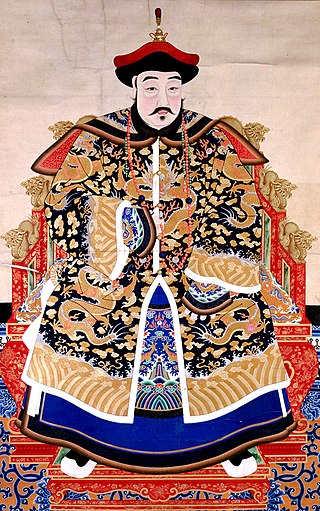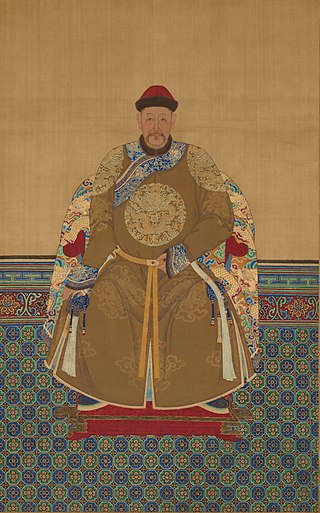
Dorgon, was a Manchu prince and regent of the early Qing dynasty. Born in the House of Aisin-Gioro as the 14th son of Nurhaci, Dorgon started his career in military campaigns against the Mongols, the Koreans, and the Ming dynasty during the reign of Hong Taiji who succeeded their father.

Hong Taiji, also rendered as Huang Taiji and sometimes referred to as Abahai in Western literature, also known by his temple name as the Emperor Taizong of Qing, was the second khan of the Later Jin dynasty and the founding emperor of the Qing dynasty. He was responsible for consolidating the empire that his father Nurhaci had founded and laid the groundwork for the conquest of the Ming dynasty, although he died before this was accomplished. He was also responsible for changing the name of the Jurchens to "Manchu" in 1635, and changing the name of his dynasty from "Great Jin" to "Great Qing" in 1636.

Dodo, formally known as Prince Yu, was a Manchu prince and military general of the early Qing dynasty.

The House of Aisin-Gioro is a Manchu clan that ruled the Later Jin dynasty (1616–1636), the Qing dynasty (1636–1912), and Manchukuo (1932–1945) in the history of China. Under the Ming dynasty, members of the Aisin Gioro clan served as chiefs of the Jianzhou Jurchens, one of the three major Jurchen tribes at this time. Qing bannermen passed through the gates of the Great Wall in 1644, and eventually conquered the short-lived Shun dynasty, Xi dynasty and Southern Ming dynasty. After gaining total control of China proper, the Qing dynasty later expanded into other adjacent regions, including Xinjiang, Tibet, Outer Mongolia, and Taiwan. The dynasty reached its zenith during the High Qing era and under the Qianlong Emperor, who reigned from 1735 to 1796. This reign was followed by a century of gradual decline.

Hooge, formally known as Prince Su, was a Manchu prince of the Qing dynasty. He was the eldest son of Hong Taiji, the second ruler of the Qing dynasty.

The Niohuru were a prominent Manchu clan during the Qing dynasty. The clan had inhabited the Changbai Mountains since as early as the Liao dynasty. The clan was well known during the Qing dynasty for producing a variety of consorts of all ranks for emperors, several of whom went on to become mothers to reigning emperors. Prominent people who belonged or trace heritage to the Niohuru clan including famed Manchu warrior Eidu, his son the high official Ebilun, the Empress Dowager Ci'an, the infamous corrupt official Heshen, the contemporary concert pianist Lang Lang and Lang Tsuyun, Taiwanese TV, movie and stage actress, singer and producer.

Ebilun was a Manchu noble and warrior of the Niohuru clan, most famous for being one of the Four Regents assisting the young Kangxi Emperor from 1661 to 1667, during the early Qing dynasty (1644–1912). A largely passive figure during the regency, Ebilun was disgraced following the ouster of the far more powerful regent Oboi and considered a political supporter of the latter. He was stripped of his positions by the emperor but later regained his noble rank. Many of his descendants became influential figures in the Qing imperial government.
Abatai was a Manchu prince and military general of the early Qing dynasty. Although an inconsistent and dissolute malcontent, he nevertheless showed considerable ability as a military leader and administrator.
Ajige was a Manchu prince and military general of the early Qing dynasty. He was born in the Aisin Gioro clan as the 12th son of Nurhaci, the khan of the Later Jin dynasty.

Empress Xiaozhaoren, of the Manchu Bordered Yellow Banner Niohuru clan, was the second wife of the Kangxi Emperor. She was empress of China during the Qing dynasty from 1677 until her death in 1678.

Nara is a clan name shared by a number of royal Manchu clans, sometimes also transliterated as Nalan or Nalland. The four tribes of the Hūlun confederation (扈倫四部) – Hada, Ula, Hoifa and Yehe – were all ruled by clans bearing this name.

Daišan was an influential Manchu prince and statesman of the Qing dynasty.
The Qing dynasty (1644–1912) of China developed a complicated peerage system for royal and noble ranks.
Jirgalang or Jirhalang was a Manchu noble, regent, and political and military leader of the early Qing dynasty. Born in the Aisin Gioro clan, he was the sixth son of Šurhaci, a younger brother of Nurhaci, the founder of the Qing dynasty. From 1638 to 1643, he took part in many military campaigns that helped destroy the Ming dynasty. After the death of Huangtaiji in September 1643, Jirgalang became one of the young Shunzhi Emperor's two co-regents, but he soon yielded most political power to co-regent Dorgon in October 1644. Dorgon eventually purged him of his regent title in 1647. After Dorgon died in 1650, Jirgalang led an effort to clean the government of Dorgon's supporters. Jirgalang was one of ten "princes of the first rank" (和碩親王) whose descendants were made "iron-cap" princes (鐵帽子王), who had the right to transmit their princely titles to their direct male descendants perpetually.

Nurhaci, also known by his temple name as the Emperor Taizu of Qing, was the founding khan of the Jurchen-led Later Jin dynasty.
, formally known as Prince Gong, was a Manchu prince of the Qing dynasty. He was born in the Aisin Gioro clan as the fifth son of the Shunzhi Emperor, making him a half-brother of the Kangxi Emperor.
Eidu was a Manchu officer and a member of the Niohuru clan.
Yonglin, formally known as Prince Qing, was a Manchu prince of the Qing dynasty in China.
Sirin Gioro was a clan of the Manchu nobility, one of the prominent Gioro family. The other clans of Gioro Hala were Aisin Gioro (爱新觉罗), the ruling clan from 1616 to 1912, Irgen Gioro (伊尔根觉罗) and Šušu Gioro (舒舒觉罗). The clan belonged to the Bordered Blue Banner. The clan members inhabited the area ranging from Nimaca, Hoifa, Changbai Mountains, Jianzhou, Ningguta and Hada.
Consort Yuan of the Bordered Yellow Banner Niohuru clan, was the wife of Hong Taiji. She was one year his junior. Later literatures have regarded her as Hong Taiji's first wife and primary consort.










